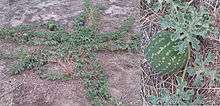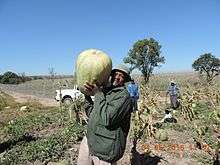Citrullus lanatus
| Citrullus lanatus | |
|---|---|
 | |
| A cultivated watermelon | |
| Scientific classification | |
| Kingdom: | Plantae |
| (unranked): | Angiosperms |
| (unranked): | Eudicots |
| (unranked): | Rosids |
| Order: | Cucurbitales |
| Family: | Cucurbitaceae |
| Genus: | Citrullus |
| Species: | C. lanatus |
| Binomial name | |
| Citrullus lanatus (Thunb.) Matsum. & Nakai | |
| Synonyms[1] | |
|
List
| |

Citrullus lanatus is a plant species in the family Cucurbitaceae, a vine-like (scrambler and trailer) flowering plant originally from West Africa. It is cultivated for its fruit. The subdivision of this species into two cultivars, watermelons (Citrullus lanatus (Thunb.) var. lanatus) and citron melons (Citrullus lanatus var. citroides (L. H. Bailey) Mansf.), originated with the erroneous synonymization of Citrullus lanatus (Thunb.) Matsum. & Nakai and Citrullus vulgaris Schrad. by L.H.Bailey in 1930.[2] Molecular data including sequences from the original collection of Thunberg and other relevant type material, show that the sweet watermelon (Citrullus vulgaris Schrad.) and the bitter wooly melon Citrullus lanatus (Thunb.) Matsum. & Nakai are not closely related to each other.[3] Since 1930, thousands of papers have misapplied the name Citrullus lanatus (Thunb.) Matsum. & Nakai for the watermelon, and a proposal has therefore been submitted to conserve the name with this meaning.[4]
The bitter South African melon first collected by Thunberg has become naturalized in semiarid regions of several continents, and is designated as a "pest plant" in parts of Western Australia.[5]
Common names
Tswana: Lekatane (s), Makatane (pl)[6]
Afrikaans: Karkoer, Bitterboela, Bitterwaatlemoen, Tsamma,[7] Kolokwint, etc.[8]
English: Tsamma melon, Wild watermelon,[7] Colocynth, etc.[8]
Nama: T’sama
Zulu: Ibhece, etc.[8]

Southern Sotho: Lehapu, etc.[8]
Description
The watermelon is an annual that has a prostrate or climbing habit. Stems are up to 3 m long and new growth has yellow or brown hairs. Leaves are 60 to 200 mm long and 40 to 150 mm wide. These usually have three lobes which are themselves lobed or doubly lobed. Plants have both male and female flowers on 40-mm-long hairy stalks. These are yellow, and greenish on the back.[9]
This plant is listed on the Threatened Species Programme of the The South African National Biodiversity Institute.[8]
Taxonomy
The bitter wooly melon was formally described by Carl Peter Thunberg in 1794 and given the name Momordica lanata.[10] It was reassigned to the genus Citrullus in 1916 by Japanese botanists Ninzo Matsumura and Takenoshin Nakai.[11]
The sweet watermelon was formally described by Carl Linnaeus in 1753 and given the name Cucurbita citrullus. It was reassigned to the genus Citrullus in 1836 by the German botanist Heinrich Adolf Schrader.
The bitter wooly melon is the sister species of Citrullus ecirrhosus Cogn. from South African arid regions, while the sweet watermelon is the sister species of mucosospermus (Fursa) Fursa from West Africa.[3]
Cultivar groups and varieties
A number of cultivar groups have been identified:[12]
- Citroides group
(syn. C. lanatus subsp. lanatus var. citroides; C. lanatus var. citroides; C. vulgaris var. citroides)[12]
DNA data reveal that C. lanatus var. citroides Bailey is the same as Thunberg's bitter wooly melon, C. lanatus and also the same as C. amarus Schrad. It is not a form of the sweet watermelon C. vulgaris and not closely related to that species.
The citron melon or makataan - a variety with sweet yellow flesh that is cultivated around the world for fodder, and the production of citron peel and pectin.[9]
- Lanatus group
(syn. C. lanatus var. caffer)[12]
C. caffer Schrad. is a synonym of C. amarus Schrad.
The variety known as tsamma is grown for its juicy white flesh. The variety was an important food source for travellers in the Kalahari Desert.[9]
Another variety known as karkoer or bitterboela is unpalatable to humans, but the seeds may be eaten.[9]
A small-fruited form with a bumpy skin has caused poisoning in sheep.[9]
- Vulgaris group
This is Linnaeus's sweet watermelon; it has been grown for human consumption for thousands of years.[9]
- C. lanatus mucosospermus (Fursa) Fursa
This West African species is the closest wild relative of the watermelon. It is cultivated for cattle feed.[9]
Additionally, other wild species have bitter fruit containing cucurbitacin.[13] C. colocynthis (L.) Schrad. ex Eckl. & Zeyh., C. rehmii De Winter, and C. naudinianus (Sond.) Hook.f.
See also
References
- ↑ "The Plant List: A Working List of All Plant Species". Retrieved April 16, 2014.
- ↑ Bailey LH. 1930. Three discussions in Cucurbitaceae. Gentes Herbarum 2: 175–186.
- 1 2 Chomicki, G.; S. S. Renner (2014). "Watermelon origin solved with molecular phylogenetics including Linnaean material: Another example of museomics". New Phytologist. 205 (2): 526–32. doi:10.1111/nph.13163. PMID 25358433.
- ↑ Renner, S. S.; G. Chomicki & W. Greuter (2014). "Proposal to conserve the name Momordica lanata (Citrullus lanatus) (watermelon, Cucurbitaceae), with a conserved type, against Citrullus battich". Taxon. 63 (4): 941–942. doi:10.12705/634.29.
- ↑ Parsons, William Thomas; Cuthbertson, Eric George (2001). Noxious Weeds of Australia (2nd ed.). Collingwood, Victoria: CSIRO Publishing. pp. 407–408. ISBN 0643065148. Retrieved 17 April 2014.
- ↑ "lekatane - Wiktionary". en.wiktionary.org. Retrieved 2016-05-19.
- 1 2 "Brochure: Bitter watermelon - Department of Agriculture" (PDF). Republic of South Africa Department: Agriculture, Forestry and Fisheries. Retrieved 2016-05-19.
- 1 2 3 4 5 "Threatened Species Programme | SANBI Red List of South African Plants". redlist.sanbi.org. Retrieved 2016-05-19.
- 1 2 3 4 5 6 7 "Citrullus lanatus (Thunb.) Matsum. & Nakai". South Africa National Biodiversity Institute. Retrieved 17 October 2013.
- ↑ "Momordica lanata Thunb.". Australian Plant Name Index (APNI), IBIS database. Centre for Plant Biodiversity Research, Australian Government, Canberra. Retrieved 17 October 2013.
- ↑ "Citrullus lanatus (Thunb.) Matsum. & Nakai". Australian Plant Name Index (APNI), IBIS database. Centre for Plant Biodiversity Research, Australian Government, Canberra. Retrieved 17 October 2013.
- 1 2 3 Porcher, Michel H. "Multilingual Multiscript Plant Name Database". Sorting Citrullus names. Retrieved 17 October 2013.
- ↑ "Citrullus lanatus (watermelon)". Royal Botanic Gardens (Kew). Retrieved 17 October 2013.
| Wikispecies has information related to: Citrullus lanatus |
| Wikimedia Commons has media related to Citrullus lanatus. |